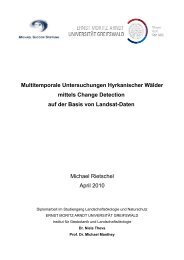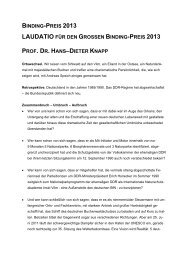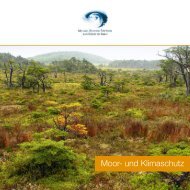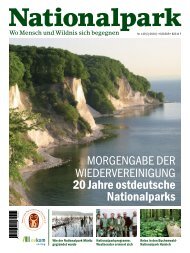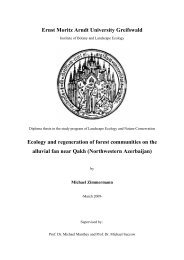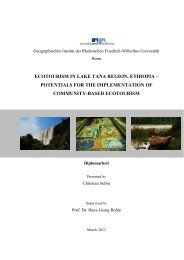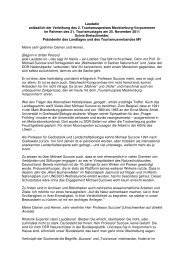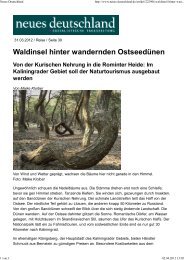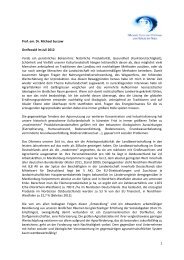Occurrence, Ecology and Conservation of wintering Little Bustards ...
Occurrence, Ecology and Conservation of wintering Little Bustards ...
Occurrence, Ecology and Conservation of wintering Little Bustards ...
Create successful ePaper yourself
Turn your PDF publications into a flip-book with our unique Google optimized e-Paper software.
Archiv für Naturschutz und L<strong>and</strong>schaftsforschung, Juni 2007 5<br />
<strong>Occurrence</strong>, <strong>Ecology</strong> <strong>and</strong> <strong>Conservation</strong> <strong>of</strong> <strong>wintering</strong> <strong>Little</strong><br />
<strong>Bustards</strong> Tetrax tetrax in Azerbaijan<br />
Kai Gauger<br />
Institute <strong>of</strong> Botany und L<strong>and</strong>scape <strong>Ecology</strong>, Greifswald University,<br />
Grimmer Straße 88, D -17487 Greifswald, Germany<br />
Keywords:<br />
Azerbaijan, conservation, ecology, <strong>Little</strong> Bustard, semi desert, steppe<br />
Abstract<br />
The <strong>Little</strong> Bustard Tetrax tetrax is a typical bird <strong>of</strong> steppes <strong>and</strong> agricultural l<strong>and</strong>scapes <strong>and</strong><br />
mainly occurs in Iberia as well as in southern Russia <strong>and</strong> Kazakhstan. Due to ploughing <strong>of</strong><br />
virgin l<strong>and</strong>, intensification <strong>of</strong> l<strong>and</strong> use <strong>and</strong> hunting the species has undergone heavy declines<br />
in the last century. It is listed as “near threatened” by the IUCN <strong>and</strong> included in the Red Books<br />
<strong>of</strong> all countries where it occurs. Today there are strong indications that the population in the<br />
Eurasian steppe belt has recovered due to outspread <strong>of</strong> fallows during the transition process<br />
<strong>of</strong> the former Soviet Union.<br />
Azerbaijan is well known to be one <strong>of</strong> the most important <strong>wintering</strong> grounds for <strong>Little</strong><br />
<strong>Bustards</strong>, but detailed <strong>and</strong> recent information is lacking. This study had the aim to clear up<br />
basic questions about the species’ <strong>wintering</strong> sites, its ecology <strong>and</strong> threats by human<br />
influences.<br />
The <strong>wintering</strong> population in Azerbaijan is estimated at more than 150.000 individuals. The<br />
results <strong>of</strong> the fieldwork show that the <strong>Little</strong> <strong>Bustards</strong> strongly prefer semi deserts <strong>and</strong> steppes<br />
under winter pasturing <strong>and</strong> avoid areas <strong>of</strong> intensive agriculture. They are quite flexible<br />
concerning the dominating plant species <strong>and</strong> the height <strong>and</strong> cover <strong>of</strong> vegetation but dependent<br />
on large, undisturbed areas. The main threats are disturbances by intensified l<strong>and</strong> use, mainly<br />
strong grazing, habitat destruction by raising infrastructure <strong>and</strong> probably also hunting.<br />
Schlüsselwörter:<br />
Aserbaidschan, Halbwüste, Ökologie, Schutz, Steppe, Zwergtrappe<br />
Zusammenfassung<br />
Die Zwergtrappe Tetrax tetrax ist ein typischer Vogel von Steppen und Agrarl<strong>and</strong>schaften auf<br />
der Iberischen Halbinsel sowie im südlichen Russl<strong>and</strong> und Kasachstan. Durch die Umw<strong>and</strong>lung<br />
ursprünglicher Lebensräume, die Intensivierung der L<strong>and</strong>wirtschaft und Jagd kam es im<br />
letzten Jahrhundert zu einem erheblichen Rückgang der Art. Sie ist von der IUCN als „potentiell<br />
gefährdet“ eingestuft und steht auf den Roten Listen aller Länder, in denen sie vorkommt.<br />
Mittlerweile gibt es deutliche Hinweise darauf, dass sich die Bestände im eurasischen<br />
Steppengürtel wieder erholt haben, was auf die Ausbreitung von Bracheflächen im Zuge des<br />
Transformationsprozesses der ehemaligen Sowjetunion zurückzuführen ist.<br />
Es ist bekannt, dass Aserbaidschan einer der wichtigsten Überwinterungsräume für die<br />
östliche Population der Zwergtrappe ist, jedoch fehlen genauere und aktuelle Angaben weit-
6<br />
gehend. Diese Untersuchung hatte das Ziel grundsätzliche Fragen zu Vorkommen, Ökologie<br />
und Bedrohungen durch menschliche Einflüsse aufzuklären.<br />
Der Winterbest<strong>and</strong> in Aserbaidschan wird auf über 150.000 Individuen geschätzt. Die Ergebnisse<br />
der Feldarbeit zeigen, dass die Zwergtrappen als Winterweide genutzte Steppen und<br />
Halbwüsten bevorzugen, intensiv ackerbaulich genutzte Bereiche hingegen meiden. Die<br />
Trappen sind recht flexibel was Artzusammensetzung, Deckung und Höhe der Vegetation<br />
angeht, jedoch angewiesen auf große, ungestörte und unzerschnittene Gebiete. Hauptgefährdungsursachen<br />
sind Störungen durch intensivierte L<strong>and</strong>nutzung, v. a. starke Beweidung,<br />
Habitatverlust durch wachsende Infrastruktur und vermutlich auch Jagd.<br />
Fig. 1<br />
Abb. 1<br />
Flock <strong>of</strong> <strong>Little</strong> <strong>Bustards</strong> in Shirvan National Park, 10.02.2006, K. Gauger.<br />
Schwarm von Zwergtrappen im Shirvan Nationalpark, 10.02.2006, K. Gauger.<br />
1 Introduction<br />
The <strong>Little</strong> Bustard Tetrax tetrax (Linné 1758) is the only species <strong>of</strong> the monotypic genus Tetrax<br />
<strong>and</strong> belongs to the family Otididae (Gruiformes). GROTE (1936) <strong>and</strong> other former authors<br />
separate the populations into the subspecies tetrax in the west <strong>and</strong> orientalis in the east, while<br />
presently they are believed to belong to only one species (CRAMP & SIMMONS 1980, CLEMENTS<br />
2000). Beside Great Bustard (Otis tarda) <strong>and</strong> Houbara (Chlamydotis undulata) the <strong>Little</strong><br />
Bustard is the smallest <strong>of</strong> the three Western Palearctic bustards. It is chicken-sized, with<br />
brown speckled body plumage, white belly <strong>and</strong> black-<strong>and</strong>-white wing feathers. Adult males<br />
have a well marked grey, black <strong>and</strong> white head <strong>and</strong> neck in the breeding season, while all<br />
birds look alike in winter. In contradiction to other bustards there is no difference in size <strong>of</strong><br />
sexes (SCHULZ 1985a).<br />
The breeding range is huge, from NW-Africa <strong>and</strong> Iberia to Siberia <strong>and</strong> the foothills <strong>of</strong> the<br />
Altai. Beside Spain <strong>and</strong> Portugal the Eurasian steppe belt in Russia <strong>and</strong> Kazakhstan is the<br />
most important breeding ground for the species. It occurs from north <strong>of</strong> the Black Sea <strong>and</strong>
southern Ural eastwards to about 85° E. The northern border in west Siberia is near Omsk<br />
(55° N) while further east 57° N are reached at Tara. In contrast to Great <strong>Bustards</strong> the <strong>Little</strong><br />
Bustard also breeds in the forest steppe. The southernmost breeding sites are the foothills <strong>of</strong><br />
Tien-Shan near Alma Ata, in Turkmenistan <strong>and</strong> Uzbekistan (GLUTZ 1994, JOHANSEN 1961).<br />
During reproduction the <strong>Little</strong> <strong>Bustards</strong> requires open, plane or slightly undulating terrain in<br />
natural steppe, extensive dry crops, pastures or fallows. The nest is built in higher grass <strong>and</strong><br />
especially the young feed mainly on invertebrates (VON FRISCH 1976, JIGUET 2002). In<br />
contradiction to the predominantly resident or short distance migrant birds in Western Europe,<br />
the eastern population is fully migratory with traditional <strong>wintering</strong> sites on the Crimea, in<br />
Transcaucasia <strong>and</strong> east <strong>of</strong> the Caspian Sea. During the non-breeding season <strong>Little</strong> <strong>Bustards</strong><br />
are gregarious <strong>and</strong> accumulate in large flocks. They occur in various steppe, semi desert <strong>and</strong><br />
agricultural l<strong>and</strong>scapes <strong>and</strong> feed on grass, herbs <strong>and</strong> annual plants, comparable to geese<br />
(DEMENTEV et al. 1951, POTAPOV 1989).<br />
7<br />
Fig. 2<br />
Abb. 2<br />
Distribution <strong>of</strong> the <strong>Little</strong> Bustard in the former USSR, map from POTAPOV (1989): a<br />
breeding range, b recent populations, c <strong>wintering</strong> grounds, d main migration routes in<br />
autumn.<br />
Verbreitung der Zwergtrappe in der ehemaligen UdSSR, Karte aus POTAPOV (1989): a<br />
Brutareal, b rezente Populationen, c Überwinterungsplätze, d Hauptzugrouten im<br />
Herbst.<br />
Once widespread <strong>and</strong> common the species got extinct in many countries (e.g. Algeria,<br />
Tunisia, Pol<strong>and</strong>, Germany, Austria, Slovakia, Hungry, Greece, Romania, <strong>and</strong> Bulgaria) <strong>and</strong><br />
strongly decreased in its remaining populations (SCHULZ 1985b, GORIUP 1994). Declines <strong>of</strong><br />
80 % from 1979-90 were recorded in France (MORALES et al. 2005) <strong>and</strong> in Italy the breeding
8<br />
range fell from 50.000 ha in 1950 to 1.200 ha in the 1980’s (PETRETTI 1985). <strong>Little</strong> information<br />
<strong>of</strong> the status <strong>of</strong> all steppe birds is available for the former Soviet Union, but e.g. in the Saratov<br />
region <strong>Little</strong> <strong>Bustards</strong> were breeding in 26 districts in 1975 but only in 10 in 1985 (BELIK 1992,<br />
MOSEYKIN 1992). Most recent estimates <strong>of</strong> the world population are given in table 1. Also in<br />
Azerbaijan there have been breeding populations. While still common in the late 19 th century in<br />
the central steppes <strong>and</strong> the foothills <strong>of</strong> Greater <strong>and</strong> Lesser Caucasus (RADDE 1884) last<br />
records date from the 1940’s in Hadjinour Steppe <strong>and</strong> 1950’s in Gobustan Upl<strong>and</strong>s<br />
(BURTSCHACK-ABRAMOWITSCH & GAMBAROW 1961, PATRIKEEV 2004).<br />
Reasons for that decline were several anthropogenic influences, principally degradation <strong>of</strong><br />
suitable habitats in the whole life cycle, including ploughing <strong>of</strong> virgin l<strong>and</strong> <strong>and</strong> the<br />
intensification <strong>of</strong> l<strong>and</strong> use with conversions to perennial crops, irrigation, pesticides use <strong>and</strong><br />
high stocking rates. Also disturbances by man <strong>and</strong> sheep-dogs <strong>and</strong> mainly poaching had<br />
strong negative effects on some populations (KASPAREK 1989, FEDORENKO 1992, FLINT 1992, DE<br />
JUANA & MARTINEZ 1996, ONRUBIA & ANDRES 2005). Hence, the <strong>Little</strong> Bustard has been<br />
evaluated as “near threatened” by the World <strong>Conservation</strong> Union (IUCN) <strong>and</strong> is included in the<br />
Red Data Books <strong>of</strong> all countries where it regularly occurs, in Azerbaijan as well. Furthermore it<br />
is listed in Annex I <strong>of</strong> the EU Birds Directive, Appendix II <strong>of</strong> the Bern Convention <strong>and</strong> CITES<br />
(AZERBAIJAN NATIONAL ACADEMY OF SCIENCES 2004, ANTONCHIKOV 2005, OZINGA & SCHAMINÉE<br />
2005, BIRDLIFE INTERNATIONAL 2006).<br />
Tab. 1 Populations <strong>and</strong> trends <strong>of</strong> <strong>Little</strong> <strong>Bustards</strong> according to De Juana & Martinez (1999)<br />
<strong>and</strong> Birdlife International (2006).<br />
Tab. 1 Bestände und Best<strong>and</strong>strends der Zwergtrappe nach De Juana & Martinez (1999)<br />
und Birdlife International (2006).<br />
country individuals year <strong>of</strong> estimation population trend<br />
France 2.700 - 4.000 99-00 declining<br />
Italy 1.000 -1.500 03 stable<br />
Portugal 10.000 -20.000 02 stable<br />
Spain 100.000- 250.000 98-02 declining<br />
Russia 18.000 -20.000 90-00 increasing<br />
Kazakhstan 20.000 96 fluctuating<br />
Turkey 30 - 60 01 declining<br />
Ukraine 100 - 110 90-00 increasing<br />
Azerbaijan holds by far the highest known concentrations <strong>of</strong> <strong>wintering</strong> <strong>Little</strong> <strong>Bustards</strong> in the<br />
world but there is only little current knowledge about approximate numbers, distribution,<br />
habitat needs <strong>and</strong> threats. This study tries to evaluate fundamental parameters <strong>of</strong> occurrence,<br />
ecology <strong>and</strong> protection.<br />
The main questions are:<br />
• How large is the winter population in Azerbaijan?<br />
• Where are the important <strong>wintering</strong> sites?<br />
• How can the habitat be characterized?<br />
• Which diet is required <strong>and</strong> where can it be found?<br />
• Which are the main direct threats <strong>and</strong> negative influences to the habitat?<br />
• How is the current protection status, where <strong>and</strong> how should it be improved?
2 Methods<br />
The fieldwork took place from end <strong>of</strong> October to mid December 2005 <strong>and</strong> from Mid January to<br />
beginning March 2006 <strong>and</strong> included the whole Kura-Arax lowl<strong>and</strong>s as well as the foothills <strong>of</strong><br />
the Greater Caucasus. First hints to <strong>wintering</strong> grounds were won from literature (especially<br />
PATRIKEEV 2004) <strong>and</strong> from local ornithologists (SULTANOV, AGAJEVA pers. com. 2005). These<br />
areas were located on satellite pictures on which additional sites were found by reflection <strong>of</strong><br />
ground <strong>and</strong> vegetation. Since these were widespread over the country observations by chance<br />
<strong>and</strong> talks to local hunters, farmers <strong>and</strong> other persons produced further information <strong>and</strong> tips to<br />
unknown sites. People were asked about spatial <strong>and</strong> temporal occurrence <strong>of</strong> the bustards,<br />
their number <strong>and</strong> hunting on them.<br />
To cover different habitats by observations also huge regions under agricultural utilization<br />
were visited. The locomotion between <strong>and</strong> within the sites was mainly done by car but goodlooking<br />
places were also crossed on foot. From hills <strong>and</strong> soil heaps along channels the horizon<br />
was scanned for flying flocks. Thereby bustards were either (i) flushed directly, (ii) flying flocks<br />
were pursued up to l<strong>and</strong>ing or (iii) droppings <strong>and</strong> feathers were found. Sitting birds were not<br />
<strong>of</strong>ten seen; they are well camouflaged or even completely covered by vegetation, furthermore<br />
large flocks had a high flight distance <strong>of</strong> some hundred meters. Every point where bustards or<br />
droppings were found was recorded by the use <strong>of</strong> a GPS device. The number <strong>of</strong> bustards,<br />
other birds, mammals, domestic animals <strong>and</strong> human activities were noted.<br />
Counting <strong>of</strong> flocks was done according to Bibby et al. (1995). Small flocks were completely<br />
counted, while large ones were estimated with the block counting method. Parts <strong>of</strong> ten ore fifty<br />
birds are counted <strong>and</strong> the flock is than separated into these or, in the following, larger blocks<br />
<strong>of</strong> hundred or thous<strong>and</strong> birds. Addition <strong>of</strong> these leads to acceptable estimates even <strong>of</strong> big<br />
flocks. A counting clock was used as well as a binocular (10x40) <strong>and</strong> a telescope (30x80). For<br />
comparison photos were taken <strong>and</strong> the birds were counted later.<br />
In the habitat analysis five parameters were included: topography, vegetation,<br />
physiognomy, l<strong>and</strong> use, distances to roads <strong>and</strong> settlements. No fixed sampling size was used,<br />
because <strong>of</strong> the different extensions <strong>of</strong> the flocks. For small groups a circle <strong>of</strong> about ten meters<br />
around the point was looked at, while for large flocks the whole area they covered was<br />
regarded. When flocks changed from one habitat to another or when a flock was extended<br />
over more then one habitat, a point was taken for each site. When flocks were seen several<br />
times at one place only one sample was taken. The topography was described by height,<br />
relief, inclination <strong>and</strong> exposition. Because there are only few plant species growing in the<br />
steppe/ semi desert in winter <strong>and</strong> it was from the beginning obvious that the bustards are not<br />
dependent on small scale differences in vegetation, only the dominating plant groups were<br />
recorded. The coverage was estimated <strong>and</strong> the height measured. For the l<strong>and</strong> use it is valid,<br />
that not only pastures, but also last season’s fields <strong>and</strong> fallows were grazed. In the measure <strong>of</strong><br />
distances only flocks larger than 500 individuals have been included. The distance to channels<br />
was only measured for points in the irrigated lowl<strong>and</strong>.<br />
For the analysis <strong>of</strong> diet it was not possible to get stomachs, so droppings were collected at<br />
different sites (each ~10 pieces). They were dried <strong>and</strong> analysed after the fieldwork by<br />
estimating the different parts <strong>and</strong> if possible identifying single components. Furthermore all<br />
available literature was collected <strong>and</strong> included into the evaluation.<br />
3 Results<br />
3.1 General parameters <strong>of</strong> distribution <strong>and</strong> occurrence<br />
At 165 points <strong>Little</strong> <strong>Bustards</strong> were recorded (fig. 3), sitting birds at 135, their droppings at 22<br />
<strong>and</strong> flying flocks at 8 places. Altogether about 213.000 birds were counted, including double<br />
9
10<br />
counts. The <strong>wintering</strong> population <strong>of</strong> an area (fig. 4) is regarded to be the maximum counted<br />
number during one visit.<br />
Fig. 3<br />
Abb. 3<br />
All records <strong>of</strong> <strong>Little</strong> <strong>Bustards</strong> during winter 2005/06, for numbers see text.<br />
Alle Nachweise von Zwergtrappen im Winter 2005/06, Zahlen siehe Text.<br />
The average density was about 55 birds per km² but rose to more than 100 in the smaller<br />
areas. The average flock size was 1502, the median was 100. 95 % <strong>of</strong> all individuals occurred<br />
in flocks larger than 1.000 birds, while more than half <strong>of</strong> the flocks held only 1 % <strong>of</strong> the overall<br />
sum (fig 5). Most <strong>of</strong> the small groups were recorded in the Shirvan NP, where they were<br />
widespread over a huge area. Apart from this area one or few large flocks were found at each<br />
site. Also in the intensively used agricultural parts <strong>of</strong> the lowl<strong>and</strong> only smaller groups up to 500<br />
individuals were detected. The largest accumulation was noticed in the evening <strong>of</strong> 02/19/06 in<br />
the northern part <strong>of</strong> the Ag-Gel NP, where up to 30.000 birds gathered.<br />
During November <strong>and</strong> December flocks <strong>of</strong> up to 2.000 birds were seen at several sites,<br />
while according to locals the mass arrived around the turn <strong>of</strong> the year, when the weather got<br />
colder <strong>and</strong> also snow fell. In January <strong>and</strong> February all sites were inhabited by the highest<br />
numbers (fig. 6). From the end <strong>of</strong> February migration seemed to begin <strong>and</strong> the flocks got<br />
distinctly smaller, the last big accumulation <strong>of</strong> about 20.000 individuals was recorded in the<br />
central Mugan on 03.03.2006.
11<br />
Fig. 4<br />
Abb. 4<br />
Size <strong>of</strong> area, number <strong>of</strong> bustards <strong>and</strong> their density.<br />
Gebietsgröße, Anzahl von Trappen und ihre Dichte.<br />
Fig. 5<br />
Abb. 5<br />
Flock sizes <strong>of</strong> all direct records.<br />
Schwarmgrößen aller Sichtnachweise.
12<br />
Fig. 6<br />
Abb. 6<br />
Temporal occurrence <strong>of</strong> <strong>Little</strong> <strong>Bustards</strong> in winter 2005/06 in selected areas.<br />
Zeitliches Auftreten von Zwergtrappen im Winter 2005/06 in ausgewählten Gebieten.<br />
Fig. 7<br />
Abb. 7<br />
Relief at all sampling points.<br />
Relief aller Aufnahmepunkte.
3.2 Habitat analysis<br />
For the habitat analysis 157 samples were taken, including all records <strong>of</strong> flocks on the ground<br />
<strong>and</strong> finds <strong>of</strong> droppings.<br />
The relief (fig. 7) at nearly all points is wide <strong>and</strong> plane, at most slightly undulating as the<br />
s<strong>and</strong>y alluvial slopes in the Ag-Gel NP or areas along the foothills <strong>of</strong> the mountains. The birds<br />
stayed away from steeper ground at least 500 m. As a peculiarity in the Shirvan NP the<br />
bustards occupied areas with vegetation covered s<strong>and</strong> hummocks <strong>of</strong> up to one meter height.<br />
The altitudes varied from -27 m close to the Caspian, up to 300 m in Samux but higher places<br />
are reached in the Gobustan Upl<strong>and</strong>s or in the Lesser Caucasus.<br />
Various types <strong>of</strong> semi deserts form the vegetation <strong>of</strong> the Kura-Arax lowl<strong>and</strong>s. PRILIPKO<br />
(1970) discerned one type predominated by Artemisia, one with dwarf Chenopodiacea shrubs<br />
<strong>and</strong> an intermediate type. He describes also lawns <strong>of</strong> halophytic annuals <strong>and</strong> meadows on<br />
moist soils near the groundwater level. More detailed description <strong>of</strong> vegetation types <strong>of</strong><br />
<strong>wintering</strong> sites are given for the Shirvan NP by SCHMIDT in this issue <strong>and</strong> for the Ag-Gel NP by<br />
STRAUSS (2004).<br />
The vegetation <strong>of</strong> the <strong>wintering</strong> sites was classified by using the predominating species<br />
<strong>and</strong> separated into five classes (fig. 8). The physiognomy is mainly short (Ø 21 cm, median<br />
25 cm) <strong>and</strong> sparse (Ø 30 %, median 36 %) (fig. 9 + 10) but outst<strong>and</strong>ing values were recorded.<br />
The least heights (<strong>of</strong> 1-2 cm) were measured on intensive grazed meadows around the Ag-<br />
Gel, while the tallest plants grew in the semi desert <strong>of</strong> Shirvan NP with lacking pasturing. The<br />
lowest coverage had a nearly bare field with sprouting winter grain, the other extreme was<br />
reached on a fallow, <strong>and</strong> where pushed down grasses <strong>of</strong> about 20 cm height completely<br />
covered the ground. At 22 sampling sites the bustards were feeding between bushes, mainly<br />
Halostachys <strong>and</strong> twice Tamarix. Their height was in some cases more than one meter, but<br />
their coverage never exceeded 5 %. At 95 % <strong>of</strong> all points fresh grass was growing (e.g. Poa<br />
bulbosa, Lolium rigidum). In the semi deserts <strong>and</strong> at salty locations it were only few plants, but<br />
in the richer steppes the coverage got much higher <strong>and</strong> reached together with young<br />
dicotyledonae (e.g. Asteraceae, Boraginaceae, Trifolium, Medicago, Geranium) up to 50 %.<br />
Artemisia dominated vegetation<br />
Most records belong to this class, <strong>of</strong> which two main distributions <strong>and</strong> types occur. First there<br />
are dry, non-salty <strong>and</strong> <strong>of</strong>ten s<strong>and</strong>y parts <strong>of</strong> the lowl<strong>and</strong>, which represent the Artemisia-semi<br />
deserts <strong>and</strong> where the height <strong>and</strong> coverage is low (~ 15 cm/ 10-30 %). Second the much<br />
richer <strong>and</strong> typically homogeneous Artemisia-steppes can be found in the higher regions<br />
around Mingeçevir reservoir <strong>and</strong> the foothills <strong>of</strong> Gobustan. Despite grazing the plants reach<br />
25+ cm <strong>and</strong> together with young grasses <strong>and</strong> other sprouting plants cover 30-80 %.<br />
Artemisia-Chenopodiaceae mixed vegetation<br />
This class represents the transition from non-salty to salty soils, where Artemisia is growing<br />
together with Chenopodiaceae, e.g. Salsola or Halocnemum. The mean height <strong>and</strong> coverage<br />
are about 25 cm <strong>and</strong> 30 %. This class occurs very widespread <strong>and</strong> holds the highest number<br />
<strong>of</strong> bustards.<br />
Chenopodiaceae semi desert<br />
Mainly salty <strong>and</strong> very dry parts are included in this class, which has the lowest coverage<br />
(~ 20 %) but with plants are up to 40 cm high. Species are e.g. Halocnemum strobilaceum,<br />
Kalidium capsicum, Salsola dendroides or Suaeda dendroides.<br />
13
14<br />
Grass dominated vegetation<br />
This type occurs in the lowl<strong>and</strong>s in the central Mugan <strong>and</strong> around Ag-Gel as well as in<br />
Gobustan. Due to grazing the height <strong>of</strong> the grasses is everywhere less than 5 cm but the<br />
coverage is the highest with up to 80 %. In patches Artemisia <strong>and</strong> <strong>of</strong>ten Alhagi pseudalhagi<br />
are growing.<br />
Others<br />
All kinds <strong>of</strong> fields <strong>and</strong> fallows belong to this class. The last season’s fields <strong>and</strong> fallows are full<br />
<strong>of</strong> herbs <strong>and</strong> grasses, while only the winter grain is free <strong>of</strong> other species.<br />
Up to three quarters <strong>of</strong> all birds were recorded in areas that are exclusively used for<br />
grazing (fig. 11). All important <strong>wintering</strong> grounds are regarded as typical winter pasture<br />
ecosystems. These are situated either along the foothills (Mingeçevir, Gobustan) or like<br />
isl<strong>and</strong>s in the intensively agriculturally used lowl<strong>and</strong> (Mil, Mugan <strong>and</strong> central Shirvan Steppe).<br />
In the rich Artemisia-steppes sheep herds with up to 1000 heads are dominating. The stocking<br />
rates are very high, e.g. in the small valley <strong>of</strong> Hadjinour with some 35.000 ha at least 30.000<br />
sheep plus few hundred cows <strong>and</strong> horses were counted. In the semi deserts the herds are<br />
smaller <strong>and</strong> more cows <strong>and</strong> water buffaloes are kept.<br />
Also out <strong>of</strong> the traditional winter pasture regions the complete lowl<strong>and</strong>s <strong>and</strong> foothills are,<br />
where they are not under crops, grazed in winter. Thus all records with no recent<br />
anthropogenic use belong to the central <strong>and</strong> northern part <strong>of</strong> the Shirvan National Park. This is<br />
the only visited sanctuary where domestic animals are in parts excluded. Therefore this is the<br />
single reference to this class. But due to the high population <strong>of</strong> Goitered Gazelles Gazella<br />
subgutturosa (see article in this issue) parts <strong>of</strong> the park look like if they were grazed <strong>and</strong> the<br />
bustards were <strong>of</strong>ten seen at the same places like the gazelles.<br />
Only at two points records were made on winter grain. Both were large flocks that were<br />
st<strong>and</strong>ing on <strong>and</strong> around single fields within wide, pastured steppes. In contrast in the<br />
agricultural lowl<strong>and</strong> with many large winter grain fields no flocks were seen that clearly<br />
belonged to these sites. More frequently small groups were seen on last season’s fields that<br />
had not been ploughed yet. The only large flock (~ 5.000 birds) which was out <strong>of</strong> the actual<br />
<strong>wintering</strong> sites was on such a field south <strong>of</strong> the Ag-Gel in the Mil Steppe. Furthermore fallows<br />
<strong>of</strong> different age in all regions <strong>and</strong> fields in the lowl<strong>and</strong>, which have been given up because <strong>of</strong><br />
too high salt concentrations, are used by the <strong>Little</strong> <strong>Bustards</strong>. In the Shirvan NP old fallows<br />
(~ 15 years) can be found, but as their vegetation is meanwhile nearly similar to the natural<br />
Artemisia-semi desert they were classified as not used. These places were <strong>of</strong>ten visited by the<br />
bustards.<br />
The distances to main roads <strong>and</strong> towns were measured at those 54 points with flocks <strong>of</strong><br />
more than 500 individuals; thereby 97% <strong>of</strong> all birds are represented (fig.12). The mean<br />
distance to asphalt roads was 10.1 km <strong>and</strong> 88 % <strong>of</strong> the birds were more than five kilometres<br />
away from them. Towards towns, which were exclusively small villages, the bustards kept a<br />
mean distance <strong>of</strong> 10.9 km <strong>and</strong> 93 % <strong>of</strong> them were at least five kilometres away from the next<br />
settlement. An exception was the above mentioned flock <strong>of</strong> ca. 5.000 birds in the Mil Steppe,<br />
which was not only out <strong>of</strong> the regular occupied areas, but also close to a main road (~ 1 km)<br />
<strong>and</strong> a town (~ 1.5 km). In the irrigated lowl<strong>and</strong> distances to channels were measured for 31<br />
points, what produced figures between 250 m <strong>and</strong> ~ 5 km.
15<br />
Fig. 8<br />
Abb. 8<br />
Records in vegetation classes <strong>and</strong> percentage <strong>of</strong> bustards <strong>of</strong> all records.<br />
Vegetationsklassen und Anteil der Trappen aller Nachweise.<br />
Fig. 9<br />
Abb. 9<br />
Vegetation heights <strong>and</strong> percentage <strong>of</strong> bustards <strong>of</strong> all records.<br />
Vegetationshöhen und Anteil der Trappen aller Nachweise.
16<br />
Fig. 10 Vegetation coverage <strong>and</strong> percentage <strong>of</strong> bustards <strong>of</strong> all records.<br />
Abb. 10 Vegetationsdeckung und Anteil der Trappen aller Nachweise.<br />
Fig. 11 L<strong>and</strong> use at all sampling points.<br />
Abb. 11 L<strong>and</strong>nutzung an allen Aufnahmepunkten.
17<br />
Fig. 12 Distances to roads <strong>and</strong> settlements.<br />
Abb. 12 Abstände zu Straßen und Siedlungen.<br />
3.3 Diet analyse<br />
Droppings <strong>of</strong> 18 sampling sites were analysed. All the compounds <strong>of</strong> the excrements<br />
resembled each other. They nearly exclusively consisted <strong>of</strong> plant material <strong>and</strong> only five times<br />
parts <strong>of</strong> beetles, probably Carabidae were found. The highest share had young grasses, which<br />
made up as much as 40 -90 %, with blades <strong>of</strong> several centimetres. In different portions among<br />
them were shoots <strong>of</strong> annuals, or even complete young plants with roots, from many families<br />
(see above). The rest were unidentified herbal plants, sometimes old <strong>and</strong> dry grasses or small<br />
wooden pieces <strong>and</strong> in low numbers, but in nearly all samples also seed <strong>of</strong> grasses,<br />
Asteraceae, Fabaceae <strong>and</strong> Chenopodiaceae. During the observations the bustards were seen<br />
feeding on Artemisia.<br />
3.4 Bird communities<br />
The Passeridae were clearly dominated by larks, which occurred in high numbers in all<br />
habitats. With a frequency <strong>of</strong> 0.6 at the sampling points, the Skylark Alauda arvensis was most<br />
abundantat, followed by Small Skylark A. gulgula, Starling <strong>and</strong> Cal<strong>and</strong>ra Melanocorypha<br />
cal<strong>and</strong>ra, Lesser Shot-toed Cal<strong>and</strong>rella rufescens <strong>and</strong> Crested Lak Galerida cristata. Most<br />
numerous were Cal<strong>and</strong>ras on fields in the Hadjinour region, where up to 100.000 individuals<br />
gathered in February. Skylarks <strong>and</strong> Starlings formed flocks <strong>of</strong> some hundreds to thous<strong>and</strong><br />
birds while the others were only seen in smaller groups. Furthermore also pipits, wheatears,<br />
finches <strong>and</strong> buntings were recorded.<br />
Raptors were very divers <strong>and</strong> some species gained high densities. Abundant at the<br />
sampling points were Hen Harrier with a frequency <strong>of</strong> 0.33, Kestrel Falco tinnunculus, Merlin<br />
F. columbarius <strong>and</strong> Long-legged Buzzard Buteo rufinus (each ~ 0.2). More uncommon were<br />
Pallid Circus macrourus <strong>and</strong> March Harrier C. aeruginousus, Aquila eagles, large falcons <strong>and</strong>
18<br />
vultures. An overview about minimum numbers <strong>of</strong> selected species in some study areas is<br />
given in table 2.<br />
Tab. 2<br />
Minimum numbers <strong>of</strong> selected raptors in some study areas.<br />
Tab. 2 Mindestzahlen ausgewählter Greifvögel in einigen Untersuchungsgebieten.<br />
Shirvan NP Ag-Göl NP Hadjinour Samux Bosdag Gobustan<br />
F. peregrinus 2 2 1 1<br />
F. cherrug 1 2<br />
F. biarmicus 2<br />
F. columbarius 10 6 8 5 5 6<br />
H. albicilla 3 2 2<br />
A. heliaca 2 6 4 2 3<br />
A. chrysaetos 2 2 2 2<br />
A. nipalensis 1<br />
A. clanga 1<br />
C. cyaneus 25 8 30 20 7 8<br />
C. macrourus 3 2 2 1 1<br />
B. rufinus 10 8 20 18 9 6<br />
G. fulvus 5 2 4 7<br />
A. monachus 13 6 2<br />
Fig. 13 Change in l<strong>and</strong> use in the Russian breeding range <strong>of</strong> the <strong>Little</strong> Bustard, numbers<br />
according to SEMELANSKY (2003).<br />
Abb. 13 Veränderung der L<strong>and</strong>nutzung im Russischen Brutgebiet der Zwergtrappe, Zahlen<br />
nach SEMELANSKY (2003).<br />
Other species <strong>of</strong> interest that have habitat requirements comparable to the <strong>Little</strong> <strong>Bustards</strong><br />
are geese. Among them Ruddy Shelduck Tadorna ferruginea was most widespread <strong>and</strong><br />
occurred also in the steppe regions. An unusually large flock <strong>of</strong> about 1.300 birds was
ecorded on fields near the Hadjinour in December. The Anser-geese were mainly restricted to<br />
the meadow habitats <strong>and</strong> winter grain fields but also semi deserts, where in the Shirvan NP<br />
Greylags A. anser <strong>and</strong> White-fronteds A. albifrons were present with each some hundreds.<br />
Around the Ag-Gel up to 2.000 Lesser White-fronted Geese A. erythropus were counted in a<br />
mixed flock with White-fronts <strong>and</strong> right beside large flocks <strong>of</strong> bustards, the same situation with<br />
2.200 Lesser White-fronts had HEINICKE & RYSLAVY (2002). From Kizil-Agach a ranger reported<br />
110 Red-breasted Geese Branta ruficollis. This species formerly wintered in Azerbaijan in high<br />
numbers but meanwhile changed its <strong>wintering</strong> grounds to the Black Sea. A single bird was<br />
seen among other geese <strong>and</strong> bustards in Gobustan.<br />
4 Discussion<br />
4.1 Origin <strong>of</strong> the <strong>Bustards</strong><br />
As shown in the introduction the breeding areas <strong>of</strong> the <strong>Little</strong> <strong>Bustards</strong> <strong>wintering</strong> in Azerbaijan<br />
lie in the Eurasian steppe belt in Russia <strong>and</strong> Kazakhstan. The l<strong>and</strong> use in this entire region<br />
drastically changed after the breakdown <strong>of</strong> the former Soviet Union. When the large Kolkhozes<br />
were privatized much <strong>of</strong> their field surface, especially unpr<strong>of</strong>itable areas, was not taken over<br />
<strong>and</strong> prices were now underlying the world marked. This lead to an outspread <strong>of</strong> millions <strong>of</strong><br />
hectares <strong>of</strong> fallow l<strong>and</strong> <strong>and</strong> the livestock numbers on natural pastures distinctly decreased<br />
(SEMELANSKY 2003, FAO 2006, fig. 13). In Kazakhstan where more than 20 Million hectares <strong>of</strong><br />
virgin steppe have been ploughed in the 1950’s, nearly that much <strong>of</strong> space was falling out <strong>of</strong><br />
use after 1991 (LENK 2005). According to SEMELANSKY (2003) the pesticide use, which is<br />
regarded as one <strong>of</strong> the most negative influences on <strong>Little</strong> <strong>Bustards</strong> (ONRUBIA & ANDRES 2005),<br />
was strongly reduced. Also the use <strong>of</strong> fertilizers sank, e.g. in the region <strong>of</strong> Saratov from<br />
45 kg/ha to 2 kg/ha in minerals <strong>and</strong> from 1500 kg/ha to 200 kg/ha in organic matter.<br />
When large natural steppe areas were converted into agricultural l<strong>and</strong> the <strong>Little</strong> <strong>Bustards</strong><br />
were partly able to adapt also to these habitats (POTAPOV 1989, BELIK 1992). Thus, it should be<br />
no problem for them to spread on new, better fallow habitats, soon. Other ground-breeding<br />
birds <strong>and</strong> steppe rodents do so as well (DIETERICH 2000). Recent studies <strong>of</strong> SHLYAKHTIN et al.<br />
(2004) from 1996- 2002 in the Saratov Oblast show that about the half <strong>of</strong> the nests <strong>of</strong> <strong>Little</strong><br />
<strong>Bustards</strong> can be found in natural steppes, but another third in fallows. In the Crau in southern<br />
France WOLFF et al. (2001) had a maximum <strong>of</strong> 4.2 displaying males per km² in areas mixed <strong>of</strong><br />
fallows, pastures <strong>and</strong> steppe. Such high densities are not reached in Saratov (max 1.1/km²,<br />
though this might also depend on the methods used), but SHLYAKHTIN expects higher numbers<br />
in other regions <strong>of</strong> Russia. SCHULZ (1985b) cites older publications with 1.2 to 4/km² in<br />
Western Siberia <strong>and</strong> GAWRIN et al. (1962) give comparable Numbers for Kazakhstan.<br />
It seems that the situation <strong>of</strong> the species in its eastern breeding range turned to a positive<br />
development after the breakdown <strong>of</strong> the Soviet Union. On fields they should pr<strong>of</strong>it <strong>of</strong> the<br />
extensivation <strong>and</strong> on natural pastures <strong>of</strong> the lower stocking rates. In the last 15 years the<br />
remaining populations had time <strong>and</strong> possibilities to recover <strong>and</strong> to regain former breeding sites<br />
with regenerating steppe habitats on fallows. Even if one calculates with the lowest densities it<br />
is evident that there is again enough space for hundreds <strong>of</strong> thous<strong>and</strong>s breeding <strong>Little</strong><br />
<strong>Bustards</strong>.<br />
4.2 <strong>Occurrence</strong> in Azerbaijan<br />
The time span <strong>of</strong> the records from late October to early March well reflects the main<br />
occurrence <strong>of</strong> the <strong>Little</strong> Bustard in Azerbaijan, though small numbers may appear earlier <strong>and</strong><br />
spring migration is extended until mid <strong>of</strong> April (PATRIKEEV 2004). The appearance <strong>of</strong> the <strong>Little</strong><br />
<strong>Bustards</strong> in Azerbaijan is strongly connected with the weather situation in the breeding range<br />
<strong>and</strong> resting sites on their flyways. Not every year brings the same numbers to Transcaucasia<br />
19
20<br />
<strong>and</strong> in mild winters parts <strong>of</strong> the population stay in the steppes north <strong>of</strong> the Greater Caucasus<br />
or arrive just very late. Nevertheless, Azerbaijan is probably the most important <strong>wintering</strong><br />
ground for <strong>Little</strong> <strong>Bustards</strong> in the world.<br />
The main migration route to Transcaucasia probably leads along the Caspian Sea, but<br />
some flocks also cross the Greater Caucasus over special passes like near Zakatala<br />
(PATRIKEEV 2004). When they have reached their traditional resting sites the birds are most<br />
likely sedentary. Only once a larger flock was seen out <strong>of</strong> the regular <strong>wintering</strong> grounds <strong>and</strong> no<br />
birds on active migration were recorded. If the weather situation is getting too bad, the<br />
bustards are able to fly on to regions further south, mainly to Iran, from where no detailed<br />
information is available. In small numbers they also reach Turkey <strong>and</strong> Georgia <strong>and</strong> some fly as<br />
far as Israel (SHIRIHAI 1996). Than they either follow the Caspian shore or the valley <strong>of</strong> the river<br />
Arax to the upl<strong>and</strong>s <strong>of</strong> Asia Minor. Extreme situations can also lead to mass dying, like<br />
reported by IWANOV & PRIKLONSKIJ (1965) from the Mugan Steppe. During a snowstorm<br />
another flock l<strong>and</strong>ed in a village <strong>and</strong> many birds were killed by the inhabitants (VERESTCHAGIN<br />
1940).<br />
The most important <strong>wintering</strong> sites (see fig. 3) were identified to be:<br />
• the area around the Mingeçevir reservoir, with the regions <strong>of</strong> Samux (1),<br />
Hadjinour (2) <strong>and</strong> Bosdag (3)<br />
• the Mil Steppe, mainly in <strong>and</strong> around the Ag-Gel National Park (4), this place<br />
seems to be one <strong>of</strong> the most important <strong>wintering</strong> sites <strong>and</strong> also a meeting place<br />
before the bustards leave again in spring (see also HEINICKE & RYSLAVY (2002)).<br />
• large parts <strong>of</strong> the central (5) <strong>and</strong> western (6) Mugan Steppe<br />
• the Shirvan Steppe, including its central parts (7), the foothills <strong>of</strong> Gobustan (8)<br />
<strong>and</strong> the Shirvan National Park (9)<br />
According to literature (RADDE 1884, VERESTCHAGIN 1940, VOROBYOVA 1992, SHELTON<br />
2001, PATRIKEEV 2004) further sites can be found:<br />
• in the Gobustan Upl<strong>and</strong>s (10); suitable sites were visited after the actual field<br />
studies <strong>and</strong> a small flock was reported as late as 12.04.<br />
• in the foothills <strong>of</strong> the north-eastern flank <strong>of</strong> the Greater Caucasus (11); sites exist<br />
in the rayons <strong>of</strong> Diviçi <strong>and</strong> Xaçmaz<br />
• in the foothills <strong>of</strong> Lesser Caucasus (12); the lower Karabakh region, could not be<br />
visited due to the situation around the Armenian occupied territory<br />
• in the northern part <strong>of</strong> the Kizil-Agach Bay (13); this site is known as an important<br />
<strong>wintering</strong> ground, but bad roads made it inaccessible, a ranger gave reports <strong>of</strong><br />
about 8.000 bustards there<br />
4.3 Population estimates<br />
Due to their supposed fidelity to the resting sites during the winter <strong>and</strong> the behaviour <strong>of</strong> the<br />
flocks the quota <strong>of</strong> recording should be quite high, but it is possible that in the largest study<br />
areas flocks were not noticed. Although the Shirvan NP was visited most <strong>of</strong>ten during the<br />
fieldwork large parts stayed uncovered by observation because <strong>of</strong> bad road conditions. The<br />
central Mugan was only visited once <strong>and</strong> in the central Shirvan Steppe only a single flock <strong>of</strong><br />
~ 5.000 birds was recorded flying in a distance <strong>of</strong> some kilometres.<br />
While the minimum number <strong>wintering</strong> in Azerbaijan in 2005/06 is estimated at 150.000, the<br />
maximum might likely not exceed 200.000. Thus, nearly counts like prior to the 1930’s<br />
(according to PATRIKEEV (2004)) are reached again after the strong declines in the last century.
However, it stays unclear how large this decline actually was, or if this assumption just<br />
depends on a lacking data basis. Also from the time when the bustards should have had their<br />
lowest population size (in the 1980’s), there are reports <strong>of</strong> very large accumulations. These<br />
were 30.000 in February 1984 in Kizil-Agach or 30.000 in central Mugan in January 1990<br />
(PATRIKEEV 2004). SHADILOV & KHAKHIN (in MARTINEZ et al. 1997) even reported amazingly<br />
100.000 in Kizil-Agach in 1990. As the other sites identified in this study probably existed<br />
under the same conditions as they do today, they were likely also inhabited by <strong>Little</strong> <strong>Bustards</strong><br />
in these times, but just not visited by any ornithologists.<br />
If the number <strong>of</strong> <strong>Little</strong> <strong>Bustards</strong> found in Azerbaijan during the winter 2005/06 is compared<br />
with the still most recent estimates <strong>of</strong> the breeding populations in Russia <strong>and</strong> Kazakhstan (see<br />
tab. 1) a lack <strong>of</strong> knowledge about their actually size gets evident. For MISCHENKO (2004) <strong>and</strong><br />
ANTONCHIKOV (2005) it is obvious that even the European Russia cannot be covered by bird<br />
surveys, in addition there is the much larger Asian part. They complain that there is hardly any<br />
information available about populations <strong>and</strong> trends <strong>of</strong> steppe birds in the former Soviet Union<br />
<strong>and</strong> do not expect such data to come up in the close future, which can be traced to lacking<br />
field studies <strong>and</strong> experts. BURFIELD (2005) states that the knowledge <strong>of</strong> breeding bird<br />
distribution especially in the Caucasus <strong>and</strong> large parts <strong>of</strong> Russia is far from complete, which<br />
gave the misleading impression that these areas were relatively insignificant for steppe birds.<br />
In fact, these regions are crucially important for these species, because they hold the last<br />
remnants <strong>of</strong> primary steppe in Europe <strong>and</strong> a substantial area <strong>of</strong> secondary steppe habitats.<br />
An indication for increasing populations <strong>of</strong> the <strong>Little</strong> Bustard is given by MISCHENKO (2004)<br />
according to the Russian part <strong>of</strong> the European project “Birds in Europe-II” in 2002/03,<br />
implemented by the Russian Bird <strong>Conservation</strong> Union. There the <strong>Little</strong> Bustard has been<br />
marked as the only species with main parts <strong>of</strong> its range in Russia, which had a strong growth<br />
<strong>of</strong> more than 50 % between 1990 an 2000. E.g. in the region <strong>of</strong> Saratov 1.300 - 1.600 pairs<br />
were breeding in the mid 1980’s (MOSEYKIN 1992) <strong>and</strong> the population rose to about 5.900 pairs<br />
(1996 - 2002, SHLYAKHTIN et al. 2004). Together with the results from Azerbaijan this leads<br />
exactly the importance which BURFIELD sees as mistaken. BIRDLIFE INTERNATIONAL (2006) <strong>and</strong><br />
recent publications still assume that 75 - 94 % <strong>of</strong> the <strong>Little</strong> <strong>Bustards</strong>´ population is<br />
concentrated in Europe <strong>and</strong> the known entire population is estimated at 240.000 individuals.<br />
This clearly has to be revised considering that at least 150.000 birds wintered in Azerbaijan<br />
<strong>and</strong> there might be even more at further <strong>wintering</strong> sites in other countries. This shows the<br />
enormous responsibility <strong>of</strong> Azerbaijan as <strong>wintering</strong> ground for a large ratio <strong>of</strong> the <strong>Little</strong><br />
<strong>Bustards</strong>´ world population <strong>and</strong> proves the lack <strong>of</strong> knowledge <strong>of</strong> its distribution in the eastern<br />
breeding range.<br />
4.4 Habitat requirements<br />
The bustards claim nearly exclusively wide open areas, most <strong>of</strong>ten with plane ground. Likely<br />
important is also the actual size <strong>of</strong> an area, none <strong>of</strong> the identified <strong>wintering</strong> sites was smaller<br />
than 100 km². Along the lower mountains these sites are given by the topography, while in the<br />
lowl<strong>and</strong> much more space was inhabited in former times. Probably only the large wetl<strong>and</strong>s <strong>and</strong><br />
reaches <strong>of</strong> Kura <strong>and</strong> Arax were excluded, today the sites are set by l<strong>and</strong> use there.<br />
The birds seem to be very flexible concerning the vegetation’s composition <strong>and</strong><br />
physiognomy which varies widely between semi deserts, meadows <strong>and</strong> steppes. They just use<br />
what each site provides. The high share <strong>of</strong> the bustard’s number in the lowest classes <strong>of</strong><br />
height <strong>and</strong> cover is caused by the fact that only large flocks were st<strong>and</strong>ing free, like on the<br />
intensively grazed meadows. All the small groups found in the Shirvan NP stayed more hidden<br />
in the vegetation.<br />
Although also fields are used in some cases, it is obvious that the <strong>Little</strong> <strong>Bustards</strong> prefer<br />
winter pastures. This kind <strong>of</strong> utilization with transhumance has left its mark on the l<strong>and</strong>scape <strong>of</strong><br />
Transcaucasia since hundreds <strong>of</strong> years. The grazing regime produces sparse <strong>and</strong> low<br />
21
22<br />
vegetation which the bustards depend on <strong>and</strong> without domestic animals (or gazelles instead)<br />
the plants might get too high <strong>and</strong> dense. On the other h<strong>and</strong> the breakdown <strong>of</strong> the Soviet Union<br />
<strong>and</strong> the following privatization <strong>of</strong> agriculture caused increasing numbers <strong>of</strong> livestock in<br />
Azerbaijan (FAO 2001), which leads to overgrazing <strong>and</strong> desert development in many regions.<br />
Further camps <strong>of</strong> the large number <strong>of</strong> refugees (up to one million) from Nagorno-Karabakh<br />
have been built up in winter pasture regions. In contradiction to former times, when<br />
transhumant movements gave the plants time to recover in summer, the herds feed there<br />
during the whole year now <strong>and</strong> cause a high pressure on the vegetation. Seriously overgrazed<br />
is e.g. the Ag-Gel NP.<br />
Fig. 14 Climatic charge for Yevlax (Mingeçevir area) <strong>and</strong> Salyan (Shirvan NP).<br />
Abb. 14 Klimadiagramme für Yevlax (Mingecevir-Gebiet) und Salyan (Shirvan NP).<br />
From autumn on, the vegetation in the Kura-Arax lowl<strong>and</strong> starts to recover after the hot<br />
<strong>and</strong> dry summer (fig. 14) <strong>and</strong> provides enough diet for the bustards. They appear to be frugal<br />
<strong>and</strong> are only dependent on enough sprouting grasses <strong>and</strong> herbal plants as food supply. These<br />
are still available in intensively grazed areas, <strong>of</strong>ten more than in the salty semi desert <strong>of</strong> the<br />
Shirvan NP. Hence, it stays unclear if grazing really causes problems due to direct<br />
competition. More likely the herds, shepherds <strong>and</strong> dogs have negative influences by<br />
disturbance. To be stressed is the fact <strong>of</strong> the numerous small flocks in the Shirvan NP, which<br />
might be explained with lacking disturbances in the quite well protected park territory <strong>and</strong><br />
probably represents a more natural distribution. If the flocks are frequently chased <strong>and</strong> have to<br />
fly up, they accumulate by connecting with other birds.<br />
The <strong>Little</strong> <strong>Bustards</strong> clearly showed behaviour to avoid disturbances by frequented roads<br />
<strong>and</strong> settlements. No trend was recognizable in the measurements <strong>of</strong> distances to channels,<br />
which mainly reflect their high density, but the bustards likely prefer to stay away from large<br />
irrigation systems. Their high mounds <strong>and</strong> the accompanying vegetation <strong>of</strong> reed <strong>and</strong> bushes<br />
along them reduce the view <strong>of</strong> the birds <strong>and</strong> thus influences the bustards` security needs.<br />
Although this could not be measured it was obvious during the fieldwork that they stayed away<br />
from single houses <strong>and</strong> farms at least one kilometre.
4.5 Threats<br />
23<br />
4.5.1 Predation<br />
Natural predators <strong>of</strong> the <strong>Little</strong> <strong>Bustards</strong> occur very widespread. However, no successful hunt<br />
could be observed, but residues <strong>of</strong> bustards were found more than 100 times in all regions.<br />
About 90 % <strong>of</strong> those birds have been plucked by mammals.<br />
Main predators are Red Fox Vulpes vulpes <strong>and</strong> Golden Jackal Canis aureus. Both were<br />
common in all study areas <strong>and</strong> most likely try to catch bustards at night, because they cannot<br />
reach the cautious flocks in daytime. VERESTCHAGIN (1940) found remains <strong>of</strong> <strong>Little</strong> <strong>Bustards</strong> in<br />
stomachs <strong>of</strong> eight foxes shot in the Shirvan Steppe. Other possible mammals that prey upon<br />
<strong>Little</strong> <strong>Bustards</strong> are wolves Canis lupus, which have been seen regularly in the Shirvan NP <strong>and</strong><br />
once in Samux, but also occur in other areas. Further it is probable that the two wild cats Felis<br />
chaus <strong>and</strong> F. lybica catch bustards. Although no indications were found, it is very likely that the<br />
shepherd dogs <strong>of</strong> which up to a dozen belong to each herd do so as well.<br />
Among birds <strong>of</strong> prey especially large falcons <strong>and</strong> eagles attempt to hunt <strong>Little</strong> <strong>Bustards</strong>.<br />
Most abundant are Peregrine Falco peregrinus <strong>and</strong> Imperial Eagle Aquila heliaca (see tab. 4).<br />
HELLMICH (1984) also mentions Eagle Owls as predators <strong>and</strong> as they are believed to breed in<br />
Azerbaijan in the lower mountains, e.g. around Hadjinour, this is also possible here. Once, a<br />
Hen Harrier Circus cyaneus was observed during unsuccessful hunting attempts <strong>and</strong> a flock <strong>of</strong><br />
~2.000 bustards was chased up when a Long-legged Buzzard Buteo rufinus was flying over<br />
them, although it did not show any signs to attack them. Usually these species feed on small<br />
birds or rodents. Also the large falcons might prefer prey which is easier to catch, such as the<br />
common Rock <strong>and</strong> Feral Doves Columba livia or Starlings Sturnus vulgaris <strong>and</strong> larks. Two<br />
White-tailed Eagles Haliaetus albicilla produced heavy excitement among resting bustards at<br />
the Ag-Gel, where later feathers plucked by a raptor were found. In contradiction another flock<br />
in Gobustan stayed very calm when two Imperial Eagles were soaring low above them.<br />
Around Hadjinour an Imperial was seen sitting close to fresh remains.<br />
4.5.2 Hunting<br />
PATRIKEEV (2004) calls commercial hunting <strong>and</strong> poaching from motor vehicles the most<br />
destructive factor in the decline <strong>of</strong> <strong>Little</strong> <strong>Bustards</strong> in Azerbaijan. Since about the 1930’s up to<br />
200 birds per car <strong>and</strong> day were shot. The <strong>of</strong>ficial quota was 30.000-35.000 per year but the<br />
actual take reached up to 50.000. In the 1940’s it decreased to about 20.000 annually<br />
(PATRIKEEV 2004). In winter 1960/61 2.500 birds were killed in the Kizil-Agach Reserve (IVANOV<br />
& PRIKLONSKY 1965). <strong>Little</strong> information is available since then but such high numbers are likely<br />
not reached anymore in these days.<br />
The unusual situation due to the bird flue in the winter 2005/06 allows in parts only<br />
suppositions here. Locals were regularly seen with arms <strong>and</strong> could <strong>of</strong>ten be questioned about<br />
hunting, but shooting <strong>of</strong> bustards was never observed directly. There was a complete<br />
prohibition <strong>of</strong> hunting for birds during the whole winter (MUSTAFAJEV pers. com. 2005), but as<br />
the hunting law in Azerbaijan is in general not pushed through that strictly <strong>and</strong> the <strong>Little</strong><br />
Bustard is actually protected at all, this was no reason to break <strong>of</strong>f chasing activities. However,<br />
it was perceptible in many conversations that the people were due to their lack <strong>of</strong> knowledge<br />
afraid <strong>of</strong> an infection with the H5N1 virus; thereby the hunting pressure was probably reduced<br />
strongly.<br />
In all study areas huntsman were seen or locals told about them at least. Where they could<br />
be asked, they admitted to shoot small numbers <strong>of</strong> <strong>Little</strong> <strong>Bustards</strong> every winter. Evidences for<br />
poaching were also recorded within the Ag-Gel NP, where fresh cartridge cases <strong>and</strong> hide-outs<br />
were found in the areas used by bustards <strong>and</strong> geese. Apparently free <strong>of</strong> hunting are most<br />
parts <strong>of</strong> the quite well protected Shirvan NP. A special situation appears to exist in the region
24<br />
<strong>of</strong> Gobustan <strong>and</strong> the adjacent lowl<strong>and</strong>. From different sources it was told that here much more<br />
birds are shot or even caught with nets annually. A hunter said that up to 20 cars would drive<br />
around in the steppe <strong>and</strong> shoot, if there was no flu. The birds are sold along the street <strong>and</strong> on<br />
the markets <strong>of</strong> Hagigabul or Kürdämir. Although these illegal markets have been forbidden<br />
some years ago, it should be no problem to buy <strong>Little</strong> Bustard, dead or alive, in normal years<br />
there (see also PATRIKEEV 2004).<br />
Azerbaijan is meanwhile well known to foreign huntsmen, likely not at least because <strong>of</strong> the<br />
lax control <strong>of</strong> the law <strong>and</strong> dubious ways to get licences quite easily. In the internet several<br />
companies <strong>of</strong>fer trips not only to shoot protected Tur Capra cylindricornis <strong>and</strong> Caucasian Deer<br />
Cervus elaphus maral in the mountains or waterfowl on the lakes <strong>of</strong> the lowl<strong>and</strong>; also the <strong>Little</strong><br />
Bustard occurs in their lists <strong>of</strong> possible prey. Nowadays also prosperous falconers from the<br />
Arabian Peninsula visit Azerbaijan in winter to train their falcons on the bustards here after the<br />
Houbaras nearly got extinct in Arabia (COMBREAU et al. 2005). These “Arabs” like they were<br />
called by locals come for hunting but are also interested in young falcons, which they want to<br />
buy here.<br />
Numbers <strong>of</strong> killed birds can hardly be estimated <strong>and</strong> more research on this topic should be<br />
done. Even if the loss <strong>of</strong> individuals is not high considering the giant flocks <strong>of</strong> <strong>Little</strong> <strong>Bustards</strong>,<br />
hunting may seriously influence by disturbance.<br />
4.5.3 Collision with lines<br />
During the field work no lines were inspected but three birds were found by accident, one<br />
under a high voltage line <strong>and</strong> two under low voltage lines. Already RADDE (1884) notes dead<br />
<strong>Little</strong> <strong>Bustards</strong> under telegraph wires <strong>and</strong> IVANOV & PRIKLONSKY (1965) had up to ten per<br />
kilometre along power lines in the Kizil-Agach reserve in the 1960’s. They further tell that<br />
locals were used to collect dead or injured birds under such lines. Most <strong>of</strong> the <strong>wintering</strong> sites<br />
are today free <strong>of</strong> any large wires. Because the lines <strong>of</strong>ten follow the main roads, bustards<br />
usually do not get too close to them. A serious danger are the low voltage lines, which are just<br />
some meters high <strong>and</strong> connect farm houses in the wide, open areas. Further investigations<br />
would be necessary to calculate approximate numbers <strong>of</strong> victims.<br />
4.5.4 Extending infrastructure<br />
The ongoing economical boom <strong>of</strong> Azerbaijan leads to an increasing pressure on the nature not<br />
only by high stocking rates, but also by raising infrastructure. All over the country towns are<br />
growing <strong>and</strong> new power stations, streets <strong>and</strong> channels are built, what causes cuts through<br />
natural l<strong>and</strong>scapes. This directly influences the <strong>Little</strong> <strong>Bustards</strong> which are dependent on wide,<br />
uncut areas. E.g. south <strong>of</strong> the Sarisu Lake a new channel is built, which leads further through<br />
the central Mugan Steppe <strong>and</strong> is accompanied by an asphalt road there. More disturbances by<br />
traffic <strong>and</strong> also better access for hunters worsen the situation <strong>of</strong> this largest <strong>wintering</strong> site <strong>of</strong><br />
the <strong>Little</strong> <strong>Bustards</strong>. Other problems are caused by refugees from Nagorno-Karabakh. In the<br />
western Mugan a large town was built up in a <strong>wintering</strong> site. Especially around the Ag-Gel NP<br />
new settlements, roads <strong>and</strong> wires affect the bustards.<br />
4.6 Protection status <strong>and</strong> recommendations<br />
Although the <strong>Little</strong> Bustard is legally protected in Azerbaijan <strong>and</strong> fines have to be paid for killed<br />
birds (MUSTAVAJEV pers. com. 2005), nobody really cares about <strong>and</strong> no controls are carried<br />
out. For the future it would be necessary to get more information to prevent hunting.<br />
Only three <strong>of</strong> the main <strong>wintering</strong> sites have a serious protection status, the National Parks<br />
Shirvan <strong>and</strong> Ag-Gel <strong>and</strong> Kizil-Agach reserve. Parts <strong>of</strong> the sites in the Mingeçevir region are<br />
included in Zakazniks, but no protection activities take place there. As shown above, the<br />
Shirvan NP is well protected in its northern <strong>and</strong> central parts, while in the southern part many
herds can be found <strong>and</strong> also refugees live within the boundaries. In the Ag-Gel NP the<br />
protection aims are definitely not reached. This probably most important resting <strong>and</strong> meeting<br />
place for <strong>Little</strong> <strong>Bustards</strong> <strong>and</strong> other endangered species like Lesser White-fronted Geese in<br />
Azerbaijan, has the worst situation <strong>and</strong> is affected by refugee camps, intensive grazing all over<br />
the year, hunting <strong>and</strong> lacking management <strong>of</strong> the park stuff. The sheep <strong>and</strong> cattle should be<br />
excluded from the park territory at least for some time to let the harmed vegetation recover.<br />
Afterwards a regulated, suitable grazing or a reintroduction <strong>of</strong> gazelles would be acceptable.<br />
The other sites seem to be not directly endangered. As the winter pastures are very<br />
important for the agriculture in Azerbaijan they will probably not be converted into fields <strong>and</strong><br />
thus preserve themselves. Problems with overgrazing occur, but still large areas appear under<br />
good conditions. Not only for the <strong>Little</strong> <strong>Bustards</strong> but in general stocking rates have to be<br />
adapted to keep the steppe <strong>and</strong> semi desert pastures as natural resource <strong>and</strong> their rich bird<br />
fauna. New infrastructure should not affect the wide open areas to save the last uncut<br />
l<strong>and</strong>scapes. An acceptable status could be reached e.g. in biosphere reserves with a suitable<br />
l<strong>and</strong> use <strong>and</strong> restricted development. Especially the steppes <strong>of</strong> Gobustan with the adjacent<br />
lower mountains <strong>and</strong> the whole Mingeçevir area would qualify for such conservation<br />
measures.<br />
25<br />
Fig. 15 Sheep herd on intensively grazed meadows within the Ag-Gel National Park, in the<br />
background the new main entrance with <strong>of</strong>fice <strong>and</strong> ranger station.<br />
Abb. 15 Schafherde auf stark beweideten Wiesen innerhalb des Ag-Göl Nationalparks, im<br />
Hintergrund der neue Haupteingang mit Büros und Personalstation.<br />
References<br />
ANTONCHIKOV, A.N. (2005): A Review <strong>of</strong> the <strong>Conservation</strong> Status <strong>of</strong> Steppe Birds <strong>of</strong> the<br />
Northern Part <strong>of</strong> the Eastern Palearctic. In BOTA, G., MORALES, M.B., MANOSA, S. &<br />
CAMPRODON, J. (eds.): <strong>Ecology</strong> <strong>and</strong> <strong>Conservation</strong> <strong>of</strong> Steppe-l<strong>and</strong> Birds. Barcelona<br />
(Lynx Editions).<br />
AZERBAIJAN NATIONAL ACADEMY OF SCIENCES (2004): Country Study on Biodiversity <strong>of</strong> the<br />
Republic <strong>of</strong> Azerbaijan. First National Report to the Convention on Biological Diversity.<br />
BIBBY, C., BURGESS, N. & HILL, D. (1995): Methoden der Feldornithologie: Best<strong>and</strong>serfassung<br />
in der Praxis. Radebeul (Neumann Verlag).<br />
BELIK, V.P. (1992): Distribution, Numbers <strong>and</strong> some Factors <strong>of</strong> the <strong>Ecology</strong> <strong>of</strong> the <strong>Little</strong><br />
Bustard in the southeast <strong>of</strong> the European Part <strong>of</strong> the USSR, International Council for<br />
Bird Preservation/ Bustard Group.
26<br />
BIRDLIFE INTERNATIONAL (2006): Birdlife's Online World Bird Database: the Site for Bird<br />
<strong>Conservation</strong>.<br />
BIRDLIFE INTERNATIONAL (2000): Threatened Birds <strong>of</strong> the World. Barcelona <strong>and</strong> Cambridge<br />
(Lynx Edicions <strong>and</strong> Birdlife International).<br />
BURFIELD, I.J. (2005): The <strong>Conservation</strong> Status <strong>of</strong> Steppic Birds in Europe. – In: BOTA, G.,<br />
MORALES, M.B., MANOSA, S. & CAMPRODON, J. (eds.): <strong>Ecology</strong> <strong>and</strong> <strong>Conservation</strong> <strong>of</strong><br />
Steppe-l<strong>and</strong> Birds. Barcelona (Lynx Editions).<br />
BURTSCHACK-ABRAMOWITSCH, N.I. & GAMBAROW, K.M. (1961): On wildlife studies in Gobustan. –<br />
Biological Studies 3: 35-40; Azerbaijan State University, Baku (in Russian).<br />
CLEMENTS (2000): Birds <strong>of</strong> the World: A Checklist, 5th edition. Vista (Ibis Publishing Co.).<br />
COMBREAU, O., LAUNAY, F. & LAWRENCE, M. (2005): Progress, challenges, <strong>and</strong> perspectives in<br />
Houbara Bustard conservation in Asia. – In: BOTA, G., MORALES, M.B., MANOSA, S. &<br />
CAMPRODON, J. (eds.): <strong>Ecology</strong> <strong>and</strong> <strong>Conservation</strong> <strong>of</strong> Steppe-l<strong>and</strong> Birds. Barcelona (Lynx<br />
Editions).<br />
CRAMP, S. & SIMMONS, K.E.L. (1980): The Birds <strong>of</strong> the Western Palearctic. London (Oxford<br />
University Press).<br />
DEMENTEV, G.P., MEKLENBURTSEV, A.N., SUDILOVSKAYA, A.M. & SPANGEBERG, E.P. (1951): Birds<br />
<strong>of</strong> the Soviet Union, Volume II. Moscow (Sovetskaya Nauka).<br />
DIETERICH, T. (2000): L<strong>and</strong>schaftsökologische Untersuchungen an Ackerbrachen im<br />
zukünftigen Biosphärenreservat „Tengis See“ in Zentralkasachstan und ihr<br />
Regenerierungsvermögen zur Steppe. Greifswald (unpublished).<br />
FAO (2001): Country Pasture/ Forage Resource Pr<strong>of</strong>iles, Azerbaijan.<br />
FAO (2006): Country Pasture/ Forage Resource Pr<strong>of</strong>iles, Russian Federation.<br />
FEDERENKO, A.P. (1992): The Reasons for the Decline in Numbers <strong>of</strong> <strong>Bustards</strong> <strong>and</strong> Means <strong>of</strong><br />
their <strong>Conservation</strong> in the Ukraine. Bustard Studies 5: 8-16, International Council for Bird<br />
Preservation/ Bustard Group.<br />
FLINT, V.E., GABUZOW, O.S., KHRUSTOV, A.V. (1992): Strategy for the <strong>Conservation</strong> <strong>of</strong> <strong>Bustards</strong>.<br />
Bustard Studies 5: 2-7, International Council for Bird Preservation/ Bustard Group.<br />
VON FRISCH, O. (1976): Zur Biologie der Zwergtrappe. Bonn (Zoologisches Forschungsinstitut<br />
und Museum Alex<strong>and</strong>er von Humbold).<br />
GAWRIN, B.F., DOLGUSHIN, N.A., KORELOV, M.H. & KUSMINA, M.A. (1962): Birds <strong>of</strong> Kazakhstan,<br />
Volume II. Alma-Ata (Akademia Nauk Kazakhskoi CCP, in Russian).<br />
GLUTZ VON BLOTZHEIM (1994): H<strong>and</strong>buch der Vögel Mitteleuropas, B<strong>and</strong> 5 Galliformes-<br />
Gruiformes. Wiesbaden (AULA Verlag).<br />
GORIUP, P.D. (1994): <strong>Little</strong> Bustard. Tetrax tetrax. – In: TUCKER, G.M. & HEATH, M.F. (1994):<br />
Birds in Europe: Their <strong>Conservation</strong> Status. Birdlife <strong>Conservation</strong> Series 3. Cambridge<br />
(Birdlife International).<br />
GROTE, H. (1936): Beiträge zur Biologie südostrussischer Steppenvögel. Otis tetrax orientalis.<br />
– Beiträge zur Fortpflanzungsbiologie der Vögel 12: 195-198.<br />
HEINICKE, T. & RYSLAVY, T. (2002): Bird Observation in Azerbaidshan. Potsdam (unpublished).<br />
HELLMICH, J. (1984): Über geflügelte Beutegreifer der Zwergtrappe (Tetrax tetrax) unter<br />
besonderer Berücksichtigung des Uhus (Bubo bubo). – Beiträge zur Vogelkunde 30<br />
(3): 169-177.<br />
IWANOW, F.W. &. PRIKLONSKIJ, S.G (1965): <strong>Little</strong> <strong>Bustards</strong> in the USSR <strong>and</strong> measures to protect<br />
their <strong>wintering</strong> grounds. – Ornitologija 7: 130-133. (in Russian)<br />
JOHANSEN, H. (1961): Die Vogelfauna Westsibiriens, III. Teil (Non-Passeres). – Journal für<br />
Ornithologie 102 (3).<br />
JIGUET, F. (2002): Arthropods in diet <strong>of</strong> <strong>Little</strong> <strong>Bustards</strong> Tetrax tetrax during the breeding season<br />
in western France. – Bird Study 49 (2): 105-109.<br />
DE JUANA, E. & MARTÍNEZ, C (1996): Distribution, abundance <strong>and</strong> conservation status <strong>of</strong> the<br />
<strong>Little</strong> Bustard Tetrax tetrax in the Iberian Peninsula. – Ardeola 43: 157-167.
27<br />
DE JUANA, E. & MARTINEZ, C. (1999): European Union Species Action Plan <strong>Little</strong> Bustard.<br />
(Birdlife International).<br />
DE JUANA, E. (2005): Steppe Birds: A Characterisation. – In: BOTA, G., MORALES, M.B., MANOSA,<br />
S. & CAMPRODON, J. (eds.): <strong>Ecology</strong> <strong>and</strong> <strong>Conservation</strong> <strong>of</strong> Steppe-l<strong>and</strong> Birds. Barcelona<br />
(Lynx Edicions).<br />
KASPAREK, M. (1989): Status <strong>and</strong> Distribution <strong>of</strong> the Great Bustard <strong>and</strong> the <strong>Little</strong> Bustard in<br />
Turkey. Bustard Studies 4: 80-113, International Council for Bird Preservation/ Bustard<br />
Group.<br />
LENK, M. (2005): 50 Jahre Neul<strong>and</strong>steppe in Kasachstan: eine kritische Bilanz. – Archiv für<br />
L<strong>and</strong>schaftsforschung und Naturschutz 44 (1).<br />
MARTINEZ, C., RUFINO, R. & BELIK, V. (1997): <strong>Little</strong> Bustard. The EBCC atlas <strong>of</strong> European<br />
breeding birds: their distribution <strong>and</strong> abundance. European Bird Census Council.<br />
MISCHENKO, A. (2004): Numbers <strong>and</strong> trends <strong>of</strong> birds in European Russia. – In: 16th<br />
International Conference <strong>of</strong> the European Bird Census Council. Bird Numbers 2004 -<br />
Monitoring in a Changing Europe. Kayseri, Turkey.<br />
MOSEYKIN, V.N. (1992): <strong>Ecology</strong> <strong>and</strong> Protection <strong>of</strong> the <strong>Little</strong> Bustard in the Saratov Region.<br />
Bustard Studies 5: 78-91, International Council for Bird Preservation/ Bustard Group.<br />
NASA VISIBLE EARTH (2005): A catalog <strong>of</strong> NASA images <strong>and</strong> animations <strong>of</strong> our home planet.<br />
ONRUBIA, A. & ANDRES, T. (2005): Impact <strong>of</strong> Human Activities on Steppic-L<strong>and</strong> Birds: A Review<br />
in the Context <strong>of</strong> the Western Palearctic. – In: BOTA, G., MORALES, M.B., MANOSA, S. &<br />
CAMPRODON, J. (eds.): <strong>Ecology</strong> <strong>and</strong> <strong>Conservation</strong> <strong>of</strong> Steppe-l<strong>and</strong> Birds. Barcelona<br />
(Lynx Edicions).<br />
OZINGA, W.A. & SCHAMINÉE, J.H.J. (eds., 2005): Target species – Species <strong>of</strong> European<br />
concern. Wageningen (Alterra).<br />
PATRIKEEV, M.P. (2004): The Birds <strong>of</strong> Azerbaijan. Bulgaria (Pens<strong>of</strong>t S<strong>of</strong>ia-Moscow).<br />
PETRETTI, F. (1985): Preliminary data on the status <strong>of</strong> the <strong>Little</strong> Bustard in Italy. Bustard<br />
Studies, 2: 165-170, International Council for Bird Preservation/ Bustard Group.<br />
POTAPOV, R.L. & FLINT, V.E. (1989): H<strong>and</strong>buch der Vögel der Sowjetunion, B<strong>and</strong> 4 Galliformes<br />
Gruiformes. Lutherstadt (Ziemsen Verlag).<br />
PRILIPKO L.I. (1970): Rastitelny Pokrov Aserbaidschana. Baku.<br />
RADDE, G. (1884): Ornis Caucasica - Die Vogelwelt des Kaukasus. Naturkundemuseum. Tiflis.<br />
SCHULZ, H. (1985a): Das Balz- und Territorialverhalten der Zwergtrappe Tetrax tetrax -<br />
Signalcharakter und intraspezifische Funktion. Dissertation, Technische Universität<br />
Carolo-Wilhelmina zu Braunschweig.<br />
SCHULZ, H. (1985b): A review <strong>of</strong> the world status <strong>and</strong> breeding distribution <strong>of</strong> the <strong>Little</strong> Bustard.<br />
Bustard Studies 2: 131-151, International Council for Bird Preservation/ Bustard Group.<br />
SEMELANSKY, I.E. (2003): Biodiversity <strong>of</strong> Agricultural L<strong>and</strong>s in Russia: Current State <strong>and</strong><br />
Trends. Moscow (IUCN Russia).<br />
SHELTON, N. (2001): Where to watch birds in Azerbaijan. Baku (Halal Print).<br />
SHIRIHAI, H. (1996): The Birds <strong>of</strong> Israel. London (Academic Press Limited).<br />
SHLYAKHTIN, G.V., TABACHISHIN, V.G., KHRUSTOV, A.V. & ZAV'YALOV, E.V. (2004): Ecological<br />
Segregation <strong>of</strong> <strong>Bustards</strong> (Otididae) in the North <strong>of</strong> the Lower Volga Region:<br />
Evolutionary <strong>and</strong> Adaptive Aspects. – Russian Journal <strong>of</strong> <strong>Ecology</strong> 35 (4).<br />
STRAUSS, A. (2004): Development Programme for the Ag-Gel National Park. Report for the<br />
Michael-Succow-Foundation Greifswald (unpublished).<br />
VERESTCHAGIN, N.K. (1940): On <strong>Little</strong> <strong>Bustards</strong> <strong>and</strong> Great <strong>Bustards</strong> <strong>wintering</strong> in Eastern<br />
Transcaucasia. – Reports <strong>of</strong> the Azerbaijan Branch <strong>of</strong> Academy <strong>of</strong> Science 5: 57-65 (in<br />
Russian).<br />
VOROBYOVA, T.D. (1992): Wintering little Bustard on the south-western coast <strong>of</strong> the Caspian<br />
Sea. Bustard Studies 5: 92-94, International Council for Bird Preservation/ Bustard<br />
Group.



